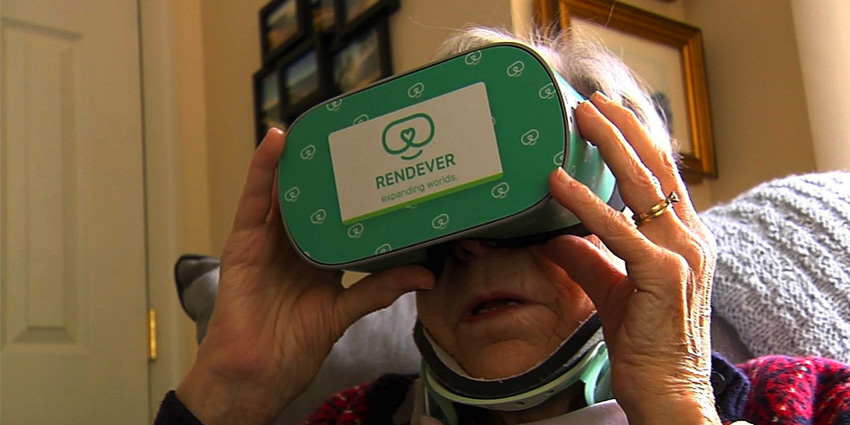As virtual reality has become more accepted over time, the use cases for this technology have become increasingly diverse. VR in nonpharmaceutical healthcare has been used in various ways, from treating mental health to pain management.
According to Verified Market Research, the virtual reality in healthcare market (valued at USD 2.14 billion in 2019) is expected to reach USD 33.7 billion by 2027, with many medical institutions expected to adopt the technology at scale within the next 10 years.
To discuss how VR is changing the healthcare landscape, we invited Tom Neumann, CTO/Co-founder at Rendever, a virtual reality platform designed to treat elderly patients, to share his insights.
Enhancing Quality of Life for the Elderly
Rendever has taken a unique approach to a specific segment of the population. According to Neumann, by working with senior living communities, Rendever has found a way to enhance the quality of life for those who spend a great deal of time isolated from the world they could once readily explore.

It’s known that social isolation and a lack of access to the world is a massive problem within senior care. VR is fundamentally the ability to be in another place, so it is ideal for addressing this problem for people who can’t quickly get around.
Neumann tells us that Rendever also incorporates reminiscence therapy into its platform. For example, residents within a senior living community who can no longer revisit the places they care about can now stand in front of their childhood home or tour a family vacation spot again in a VR headset. Add to that the ability to share those moments with others in that immediate community, making for a compelling experience.
Often people are leaving their family and friends behind when they move into senior living communities. They are with a new group of people that they don’t know, which results in less meaningful social interaction and takes a toll on the individual’s emotional and psychological needs.
However, through immersive VR, residents can bring the people they are now with back to their old neighborhood and show others a little bit of themselves and their lives.
Ultimately, the core of connecting to another person is a common shared experience. Whether it’s bringing others back to a familiar place or taking them on a new virtual adventure, the platform creates positive, enjoyable experiences that are not otherwise possible in a senior living setting.
Better Access, Better Experiences
One of the obstacles with engagement is that not everyone sees cutting edge tech and seniors going hand in hand. To overcome skepticism, ease of use has become the primary focus. Seniors may not have grown up with computers and gaming devices, so dissecting possible entry barriers is critical.
For example, the controllers themselves presented a challenge for some users. For others navigating a virtual interface proved to be a steep learning curve. Rendever conducted the research and trials to ensure that interaction was straightforward. Even if a user is not comfortable with certain aspects of the device, they can still have a quality experience with the technology. Neumann adds:
“We did a lot of work to make sure the user interface was accessible and easy to use. If anyone isn’t comfortable with the tech, they can still put on the headset and participate in the experience”
An additional hurdle for adoption is that senior living communities do not traditionally have the best technical infrastructure. High resolution is required for quality VR video to be used optimally, especially with multiple headsets in use on the same Wi-Fi network.
To remediate network restrictions within most senior communities, Rendever developed technology to synchronize the VR video in a way that does not monopolize the bandwidth. This way, VR content can be accessed from the cloud, and staff can perform other facility operations.
In 2020, with the onset of COVID, a new set of obstacles emerged. Normally sessions run in groups as part of the residents’ regular activity schedule. Headsets would be shared amongst multiple people in one room. With the gravity of COVID restrictions for a vulnerable population, that was no longer an option.
Rendever also developed new features to allow for voice communication between headsets. If people were in different rooms or even on another continent, their cloud-based platform could safely and flexibly provide immersive social interaction.
Sharing the Future With Aging Populations
There is a push to use technology to improve the quality of life within senior living communities in more tech-savvy ways. Whether it’s implementing VR, smart home devices, or digital record-keeping, senior citizens will engage with advanced technology like never before. Neumann states:
“With the evolution in the technology things will become more convincing. Real world imagery will eventually have parallax which means you can move around in it, making it a more immersive and powerful experience”
There are developing prospects for AI that enables better fall detection. Even brain-computer interfaces are beginning to enter the conversation of what’s possible with VR. All of these promising developments bring new excitement to the realm of social VR.
Increased ease of use and improved accessibility can connect seniors to a world that can often seem out of reach.
For more examples of how Rendever is changing the healthcare space for seniors and adult caregivers, check put the company’s blog.







